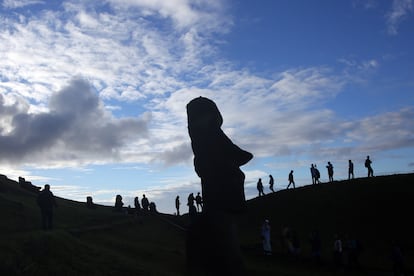In the navel of the world or in the middle of nowhere, according to what we have learned, Easter Island, mounted this week a kind of Polynesian revolution. Rapa Nui, the indigenous name of the Chilean territory protected by the 'moais', brought together more than a hundred authorities from twenty delegations from territories in the Pacific Ocean to demand that the world stop throwing its garbage into the sea and, therefore , to their front yards. The remote Chilean triangle, inhabited by about 7,000 people, has led the anti-pollution crusade because it is a particularly affected area: at the epicenter of the South Pacific Gyre, a huge whirlpool where waste transported by sea currents from Australia and South America accumulates and of the ships. The island receives 50 times more plastics and microplastics than the coasts of mainland Chile, according to municipal data. “We are receiving the world's garbage,” claimed Mayor Pedro Edmunds, promoter of the international event that ended this Friday with the signing of a declaration by several community representatives to protect the oceans.
For example, a button. At the close of the three-day summit, the organization invited representatives from Polynesia, Europe and Asia, as well as academics and civil society experts, to collect trash on Anakena Beach. The place of white sand, surrounded by meadows and palm groves in front of Ahu Nau Nau, a row of seven 'moai' that turn their backs to the waves, revealed the urgency that the meeting displayed: in just one hour , the fifty collectors gathered five kilos of garbage, most of it microplastics from indecipherable objects. They could be remains of buoys or nets thrown by ships or hulls of factories that surround the 160 square kilometer territory. “The most remote island on the planet is already experiencing this problem. We have a micro-trash collection plan and we take out a garbage truck weekly. But it is not enough,” said the mayor.
The 2024 Pacific Leaders Summit for the Protection of the Oceans and the Challenge of Plastic Pollution and Microplastics in the region issued a declaration that recognizes the existence of a triple planetary crisis associated with climate change, the loss of biodiversity and pollution. The text signed by local representatives of the Pacific Triangle establishes a commitment to undertake actions to protect, conserve and sustainably use the oceans, collaborate in the implementation of international law and promote effective governance, among other points. The document will be presented at the Future Summit of the United Nations (UN) next September in New York, United States.
Plastic pollution not only environmentally affects the island declared by UNESCO as a World Heritage Site in 1986. It also affects its ancient culture. “Before we went out to collect shells and came home to prepare soup, but now those small mollusks have microplastic and that affects our gastronomy, the practices of the community,” lamented the Director of Environment of the Municipality of Rapa. Nui, Vairoa Ika Guldman. Of the total pollution that exists in the sea, 85% is plastic and 80% corresponds to activities carried out on land, according to the UN.
María José Torres, representative of the United Nations in Chile, then warned of the impact of plastic on the maintenance of biodiversity and particularly on fishing and tourism on the islands. “It affects the health of the ocean, but also human health through food systems. Since 2020, the UN established, by decision of the States, a coalition to reduce plastic pollution by 80% by 2040,” he points out at the event in which representatives of the Polynesian Triangle territories – with Hawaii, New Zealand and Rapa – participated. Nui in its corners -, as well as ambassadors from countries such as France, Peru and China. Torres Somos focused on efforts to reuse, reduce and limit the impact of plastic on maritime and human life. “We are trying to generate that binding legal instrument that can allow countries to adhere to a series of goals, as we have done, for example, with the Paris Convention,” she noted.

The legal instrument is a draft that 175 UN member states are working on and that at the end of the month will have its fourth of the five negotiating tables planned in Canada to reach a compromise that the countries must then sign. Some of the contents address deadlines to reduce plastic by 2030 and 2050, a structure to account for progress and make solutions more flexible depending on the territories. The undersecretary of the Chilean Ministry of the Environment, Maximiliano Proaño, present at the meeting, highlighted that the signed commitment helps the islands raise their voices where plastic pollution “is manifested much more radically. As the Fijian minister said, the oceans are their means of subsistence. It is a sense of urgency that calls us to include them in a better way and to be even more ambitious in the actions that can respond to the effect they have on the islands over the continent,” he said.
The UN recognized Rapa Nui as a mirror territory of the Sustainable Development Goals of the 2030 Agenda due to its range of initiatives that seek to educate from childhood on the importance of protecting nature, through recycling and reuse, as well as how to promote sustainable practices for economic development. In Chile, 43% of jurisdictional waters have some level of protection, when the goal set by the international community is to protect 30%. More than 17 million metric tons were polluting the ocean in 2021, a figure that, according to UN projections, will double or triple by 2040 if action is not taken today.
Subscribe here to the EL PAÍS Chile newsletter and receive all the key information on current events in the country.
#Easter #Island #Polynesian #territories #hit #table #demand #stop #plastic #reaches #shores